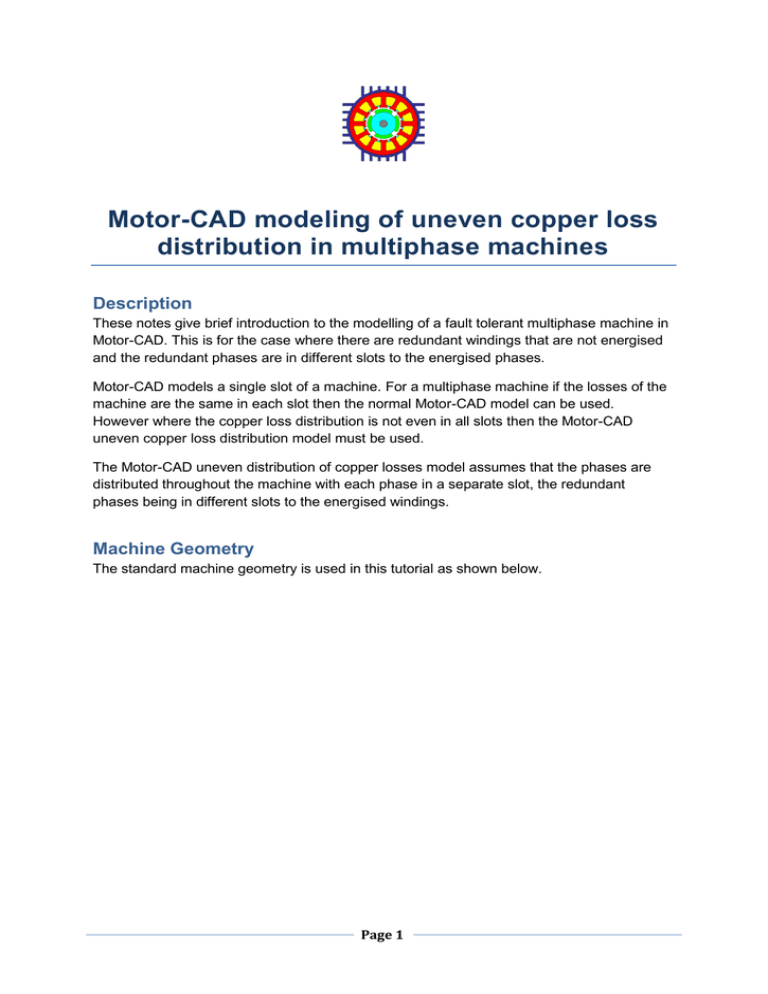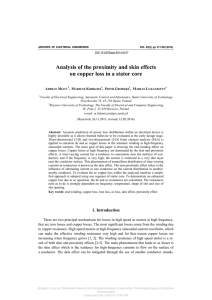Motor-CAD modeling of uneven copper loss
advertisement

Motor-CAD modeling of uneven copper loss distribution in multiphase machines Description These notes give brief introduction to the modelling of a fault tolerant multiphase machine in Motor-CAD. This is for the case where there are redundant windings that are not energised and the redundant phases are in different slots to the energised phases. Motor-CAD models a single slot of a machine. For a multiphase machine if the losses of the machine are the same in each slot then the normal Motor-CAD model can be used. However where the copper loss distribution is not even in all slots then the Motor-CAD uneven copper loss distribution model must be used. The Motor-CAD uneven distribution of copper losses model assumes that the phases are distributed throughout the machine with each phase in a separate slot, the redundant phases being in different slots to the energised windings. Machine Geometry The standard machine geometry is used in this tutorial as shown below. Page 1 Winding Design The winding definition in the slot being modelled should be entered in the winding editor as shown below. In this case the slot has a total of 350 conductors in the slot. The total number of conductors in the slot should also include any non energised conductors, this is to ensure the correct amount of copper in the slot. Note: The Motor-CAD model assumes that the conductors for each phase are evenly distributed throughout the slot. Uneven copper loss distribution Cooling options, losses and other machine details should now be entered into the model. In this machine there are 2 x 3 phase windings with only 1 of the 2 sets of windings energized. Page 2 This is added to the model as shown below. . Steady State Analysis The steady state results are calculated by selecting the schematic tab as shown below. The copper losses and winding temperatures are highlighted below. The active and end winding copper losses, the power removed from the stator back iron and the winding temperatures can be seen in the steady state schematic. To compensate for the increased copper losses in the slot (due to the uneven distribution) the power is removed Page 3 from the stator back iron. The uneven copper loss distribution results can be compared with the steady state results for the same model without the uneven copper loss distribution as shown below. The comparison of the results between even and the uneven distribution of copper losses can be seen in the table below. The average winding temperature for the energised windings has been increased by approx 9 degC due to the uneven distribution of losses. Page 4 Active section copper losses (W) End winding copper losses (W) Stator back iron losses (W) Average Winding Temperature (degC) Winding Hot Spot Temperature (degC) Even distribution copper loss model 69.8 50.2 30 113.0 114.9 Uneven distribution copper loss model 139.5 100.4 -90 121.9 125.7 Page 5 Simple Transient Analysis A simple transient analysis of this machine can be run. The analysis is set up as shown below. Selecting the Transient Graph tab will automatically run the transient analysis and produce the temperature graph shown below: Page 6 The stator copper losses and the stator back iron power (losses + compensation) can be viewed. The compensation power removed from the stator back iron varies with time to take account of the storage capacitance effects in the system. Page 7 Duty Cycle Analysis Transient analysis of this machine can also be made. The duty cycle is set up as shown below. Note it is not possible to use the Motor-CAD stall calculation when using the uneven copper loss distribution so all speeds in the transient must be > 0. Selecting the Transient Graph tab will automatically run the transient analysis and produce the temperature graph shown below: Page 8 The variation in losses and the stator back iron compensation power can also be viewed as shown below. Conclusion This example has shown how the steady state and transient performance of a machine with unbalanced copper losses can be modelled in Motor-CAD. Page 9




